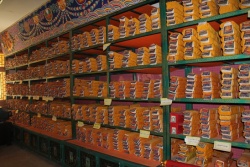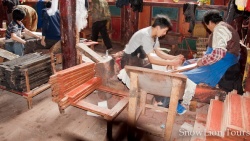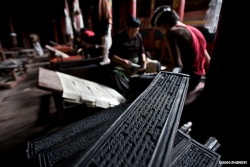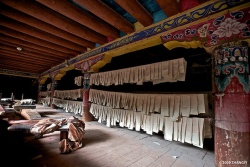Tengyur: Table of Contents of the Teachings
The term Tengyur (བསྟན་འགྱུར་, ) means “translations of the treatises [on the word of the Buddhas].” This group of texts is a collection of commentaries and treatises on the teachings of the Buddhas by Buddhist masters, the vast majority of whom were Indian.
The structure of the Degé Tengyur may perhaps be thought of as a mirror image of the Degé Kangyur: the basic arrangement here is Tantra, Sūtra, and Vinaya, as opposed to the Kangyur’s Vinaya, Sūtra, and Tantra. The principle editor of the collection, Zhuchen Tsültrim Rinchen (ཞུ་ཆེན་ཚུལ་ཁྲིམས་རིན་ཆེན་, 1697-1774 CE), notes this difference by referring to the arrangement of the Kangyur as a “low-to-high” structure (conceived presumably in terms of soteriological authority), and his arrangement of the Tengyur as a “high-to-low” structure.
Zhuchen’s catalog of the Tengyur (see reference below) has become one of the most influential Tibetan statements on the arrangement of the Tengyur collection, and circulates with the Degé Tengyur itself, printed in its final volume. The catalog makes mention of a variety of alternative ways of arranging the Tengyur, illustrating that traditional bibliographers were actively involved in debates about the ordering of canonical literature: “In general,” Zhuchen writes, “the order in which the scriptures are placed may be as follows. In accord with how they are studied by those who wish to enter the sanctuary of thinking people and scholars, the treatises may be arranged with the fine arts first, then medicine, grammar, logic, and the inner arts [of Buddhism].” But there are other options as well: “Alternatively,” he continues, “they may be arranged in accord with how they are taken into one's experience: monastic conduct, sūtra, and metaphysics (ཆོས་མངོན་, ). Or they may be arranged from low to high: worldly treatises, external arts, internal arts, the lesser way, and the common and uncommon greater ways.” “None of these are wrong,” Zhuchen relates, “but here [in the Tengyur] they will be arranged from high to low.”
There are several ways to begin unpacking Zhuchen’s arrangement of the Tengyur. Perhaps the simplest is to look the pages of the Degé Tengyur itself, where the margin of each folio contains a section heading. Taken together, these headings produce a flat list that groups the Tengyur texts into fourteen basic sections:
Collected Hymns (བསྟོད་ཚོགས་, , D.1119-D.1189)
Tantra (རྒྱུད་, , D.1190-D.3812)
Perfection of Wisdom (ཤེར་ཕྱིན་, , D.3813-D.3850)
The Central Way (དབུ་མ་, , D.3851-D.4008)
The Sūtra Section] (མདོ་སྡེ་, , D.4009-D.4048)
Mind Only Philosophy (སེམས་ཙམ་, , D.4049-D.4114)
Metaphysics (abhidharma) (མངོན་པ་, , D.4115-D.4132)
Monastic Discipline (འདུལ་བ་, , D.4133-D.4178)
Rebirth Tales (སྐྱེས་རབས་, , D.4179-D.4186)
Epistles (སྤྲིང་ཡིག་, , D.4187-D.4231)
Logic and Epistemology (([[[ཚད་མ]]]]་, , D.4232-D.4297)
Sūtras on the Language Arts (སྒྲ་མདོ་, , D.4298-D.4333)
Medical Arts (གསོ་བ་རིག་པ་, , D.4334-D.4340)
Miscellaneous (སྣ་ཚོགས་, , D.4341-D.4495)
Zhuchen’s detailed catalog of the Tengyur uses these groupings for the most part, but places them in a formal outline, and then divides them into sections and sub-sections, resulting in a very dense outline with more than 300 sections. Zhuchen’s outline is complicated by the fact that it uses two further organizing schemes. First, his catalog divides the Tengyur into five main “parts” (སྐབས་, ):
Opening Praises (D.1119-D.1189; 71 texts)
Tantra (D.1190-D.3812; 2623 texts)
Exoteric Buddhism (D.3813-D.4373; 561 texts)
Miscellaneous (D.4374-D.4404; 31 texts)
Concluding Dedications and Prayers (D.4405-D.4449; 45 texts)
On top of this “five parts” scheme, Zhuchen’s catalog superimposes another organizational hierarchy, which is the “five arts” (རིག་པའི་གནས་ལྔ་, ):
The Inner Arts (i.e. Buddhism) (ནང་གི་རིག་པ་, , D.1190-D.4231)
The Art of Reasoning (གཏན་ཚིགས་ཀྱི་རིག་པ་, , D.4232-D.4297)
Language Arts (སྒྲའི་རིག་པ་, , D.4298-D.4333)
Medical Arts (གསོ་བའི་རིག་པ་, , D.4334-4340)
Arts and Technologies (བཟོ་རིག་པ་, , D.4341-4355)
Zhuchen’s “five parts” and “five arts” organizations do not fit neatly together in a single outline, so here in the THL catalog of the Tengyur, we have followed the “five parts” scheme, as it is by far the most dense and sophisticated of the two. In the THL Catalog Outline, each of Zhuchen’s detailed categories are reproduced, and users can expand them and view their individual contents by clicking on the + signs that appear next to the categories.
Zhuchen Tsültrim Rinchen (zhu chen tshul khrims rin chen), Kun mkhyen nyi ma'i gnyen gyi bka' lung gi dgongs don rnam par 'grel pa'i bstan bcos gangs can pa'i skad du 'gyur ro 'tshal gyi chos sbyin rgyun mi 'chad pa'i ngo mtshar 'phrul gyi phyi mo rdzogs ldan bskal pa'i bsod nams kyi sprin phung rgyas par dkrigs pa'i tshul las brtsams pa'i gtam ngo mtshar chu gter 'phel ba'i zla ba gsar pa/ (Degé Tengyur, vol. shrI). Also published as Kun mkhyen nyi ma’i gnyen gyi bka’ lung gi dgongs don rnam par ’grel pa’i bstan bcos gangs can pa’i skad du ’gyur ro ’tshal gyi chos sbyin rgyun mi ’chad pa’i ngo mtshar ’phrul gyi phyi mo rdzogs ldan bskal pa’i bsod nams kyi sprin phung rgyas par dkrigs pa’i tshul las brtsams pa’i gtam ngo mtshar chu gter ’phel ba’i zla ba gsar pa (Lhasa: Bod ljongs mi dmangs dpe skrun khang, 1985).
Eimer, Helumt and David Germano (eds.). The Many Canons of Tibetan Buddhism: Proceedings of the Ninth Seminar of the International Association for Tibetan Stuidies, Leiden 2000. Leiden: Brill, 2002.
Kolmas, Josef. The Iconography of the Derge Kanjur and Tenjur. New Delhi: Sharada Rani, 1978.




